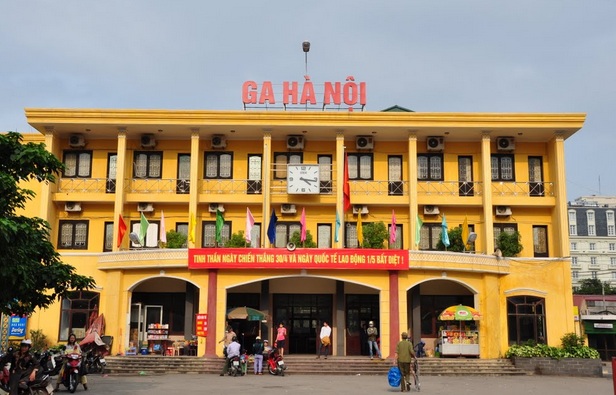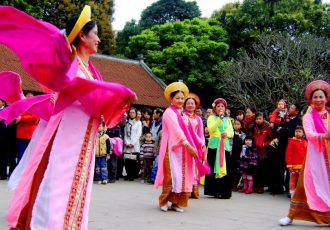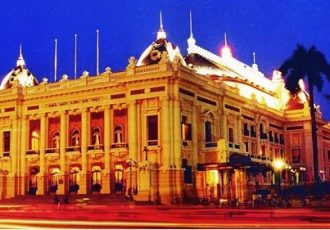Summary
Introduction
Hanoi is the capital of Vietnam. It is located in the North of the country, it borders the course of the Red River (Sông Hồng) which flows into the Gulf of Tonkin. Its name means “the city beyond the river” which is explained by its geographical position. Hanoi is the second largest city in Vietnam, after Ho Chi Minh City. The population density is high with about 6.5 million inhabitants.
The city of Hanoi is all in contrast, on the one hand the incessant effervescence expressed by a dense and twirling traffic, on the other an apparent calm with well preserved ancestral traditions.
Hanoi is a unique city that leaves most travelers amazed and touched by their time here. It is such a wonderful mixture of smells, colors, disorderly constructions, superimposed stories that no one remains indifferent. Vietnamese people believe that Hanoi was born to represent Vietnam!
Horizon Vietnam Travel invites you to discover in depth our Hanoi of heart! You will find in this very complete section all the interesting information you need to know for your stay in Vietnam.
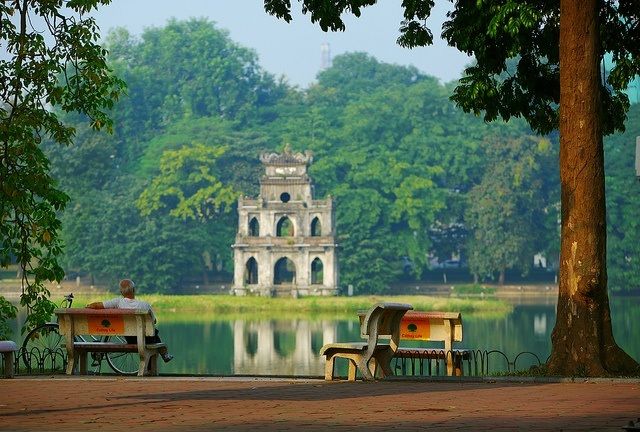
General Information Hanoi
– Area: 3328.9 km2 – Hanoi is one of the largest city in Vietnam.
– Population: 5,067,000 inhabitants (according to the recent in 2022)
– Density: 2,455 people/km² (according to the recent in 2020)
– The president of the city:
What time is it in Hanoi, Vietnam?
Located 9210 km from Paris, there is a 6 hour time difference in winter, and 5 hours in summer compared to France
Hanoi climate, when to go to Hanoi?
It is considered that there are four seasons in Hanoi. Thanks to the two transition periods (April and October) between the two hot and cold seasons, Hanoi has four seasons: spring, summer, autumn and winter.
Spring in Hanoi usually starts in February and ends in April. Summer lasts from May to July. Fall occurs around August, September and October. Winter comes in November and ends in January next year.
The best time to visit Hanoi is from October to December and from February to April, at these times the temperatures are mild, with beautiful sunshine and low rainfall. Winter, from December to January, is an interesting alternative, but the weather is often cool and gray. In summer the temperatures can be unpleasant because it’s very high (about 38-39 degrees), the climate is humid with heavy rainfall.
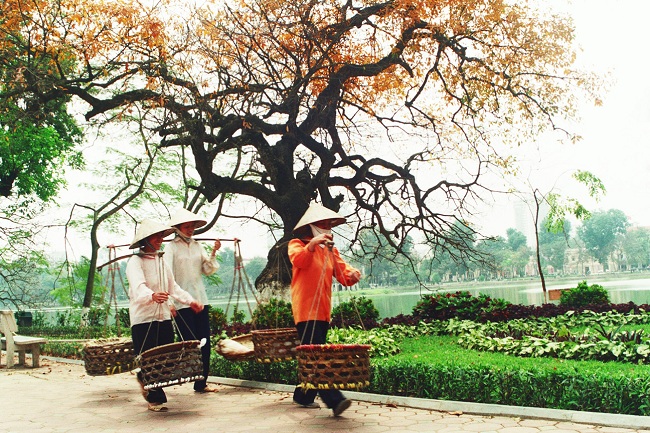
How to go to Hanoi?
Hanoi International Airport
Behind Tan Son Nhat in Ho Chi Minh City, Hanoi Airport is the second largest terminal in Vietnam. It is located in the district of Soc Son, 45km north of the center of Hanoi.
It offers domestic lines with all major cities of Hanoi and international flights to major Asian cities such as: Singapore, Hong Kong, Macau, Taipei, Tokyo….
From Europe, there are many connections with European cities such as Paris (several weekly flights), Amsterdam (three weekly flights), Copenhagen (every Thursday), Madrid (every Monday, Friday)…
Once at the airport, you can take a bus (40,000 DONGS, approx. 1 hour) to reach the center. The bus numbers that you should remember are 07 and 17. The 07 bus will cross from Thang Long Bridge to Cau Giay. And the 17 bus go to the Old Quarter via Chuong Duong Bridge.They run every 20 minutes between 4:30 a.m. and 9:00 p.m. You can also take a taxi to go to the center of the city but we wouldn’t recommend cause it’s not cheap (approx. 370,000- 470,000 DONGS about $17 – $20). The price will change depending on the 4 seaters or 7 seaters taxi.
Hanoi train station
Where is Hanoi train station?
Hanoi Railway Station is located at 120 Le Duan Street, just 1 km from the city center or the Thirty-six Trades District. The main building is very easily recognizable: an old building dating from the time of French Indochina, overlooking Le Duan Street, a very important North-South axis of Hanoi. Previously, the street was known as Mandarine Street from where the main communication routes departed to the important corners of the country: South Vietnam, the mountainous North, the coastal provinces to the East.
It is in this main building that you can find the main counters of the Vietnamese Railways for North-South journeys (Hanoi to Ho Chi Minh City).
Ticket sales for the Hanoi-Lao Cai or Hanoi-Hai Phong line are in another much smaller building and facing Tran Quy Cap Street – the west side of the station.
In recent years, the infrastructure of Hanoi station has been greatly modernized and improved, the hall space is also covered by wifi. Many chairs are installed there to serve passengers waiting for trains. Only, car and bus parking lots remain narrow, sometimes it’s a bit chaotic at rush hour!
Once on the station platform, it will be important to know this: the North-South trans-Vietnamese trains (to Ho Chi Minh City) are recognized by their names starting with SE (so we have SE 1, SE 2, SE 3, SE 4, SE 5…). While the Hanoi-Lao Cai trains are recognized by their names starting with SP (we then have SP 1, SP 2, SP 3, SP 3…).
How to get around in Hanoi?
Compared to other Asian capitals, Hanoi is not so big, visiting the city center and the 36 corporations district will be easily done on foot. But to reach the other sites a little further away, the easiest way will be to take a taxi. The prices will seem remarkably low compared to France: count two or three euros for a 5 kilometer race.
The bus network is also well developed and really cheap, but it is of course more complicated to find your way around.
What to see, what to do in Hanoi?
Of course, there are many other places in Hanoi full of charm and culture, such as The Museum of Ethnography of Hanoi, Hoan Kiem Lake, The One Pillar Pagoda, The Temple of Literature… We detail these sites in this section: Site to see
But let’s see below a very special site to visit when you go to Hanoi!
Hanoi and its 36 guild streets
If there is one place that should be mentioned when talking about Hanoi, it is the district of 36 streets and corporations. This place is considered the soul of Hanoi. It is indeed difficult to imagine visiting the capital without walking the famous 36 streets and corporations in Hanoi, this is a must-see place in our capital. And yet, in the past some innovative spirits evoked the idea of demolishing the old quarter in order to build large “buildings”… Fortunately the municipality never listened to them, and even if, the money was lacking to carry out this project. And yes, poverty has its good side, it has preserved this national treasure where it is good to walk.
The authenticity of these places is miraculously maintained in the middle of this city in perpetual motion!
A few foreign friends said, “If your Hanoi didn’t have it anymore, it would be pretty plain.” They generally prefer Hanoi to Saigon, because Hanoi has a millennial history. The soul of the city remains in this district which is distinguished from the new by its artisan and merchant shops.
Built in the 15th century, this district of merchants and craftsmen draws a triangle located on the North shore of Hoan Kiem Lake (Lake of the restored sword). This historic heart of the capital retains its old style and human size. You can wander around on foot or by rickshaw, and forgetting the din of scooters. It is not difficult to imagine what the city looked like in the past with its swarms of merchants and vendors, craftsmen and shopkeepers. itinerant: jeweller, calligraphers, carpenters, sellers of fans, patterned objects, lacquers, silk, mats, paper, pipes, manufacturers of chests, jars, rattan or leather objects. ..Ou dormir à Hanoi?
The Old Quarter of Hanoi and its surroundings are filled with a large number of hotels of very different categories and styles. So, no worries about shortage of rooms if you are planning to go to Hanoi!
From the room for the backpacker to the luxury category, all ranges are available. In the same way the prices exist for each category of wallet! Namely, that on average the hotel industry in Vietnam is much cheaper than in Europe.
To book a hotel, it’s very simple: go to specialized sites or call on our agency to obtain the best prices for a trip organized by us.ici
Hanoi and the 36 old quarters have been ranked among the top 10 most attractive cities in the world. You would then ask yourself these questions: “What are the attractions of this city?” or “What are the sites to see first upon arrival in this city?
Festivals in Hanoi
Hanoi – the heart of Vietnam is considered a treasure trove of beautiful cultural traditions. It is a place where the traditional festivals of the Vietnamese people take place. These festivals are spiritual nourishment for the Vietnamese in general and the Hanoians in particular. If you are lucky enough to be in Hanoi during these festivals you will have a unique experience.
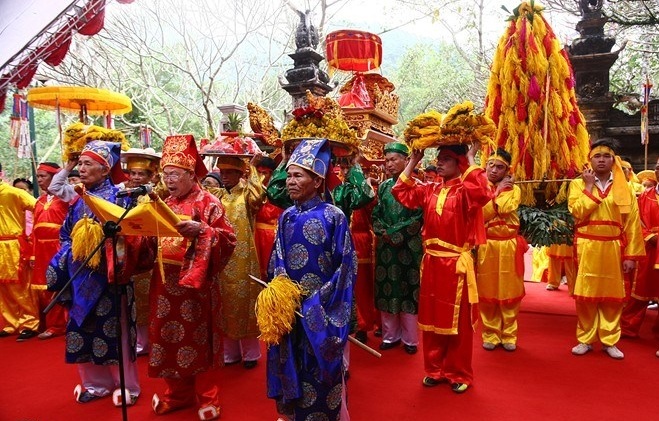
DONG DA FESTIVAl
Dong Da Festival is held on the 5th day of the first lunar month every year. It is a celebration in commemoration of the resounding victory of the uprising led in 1788 by Emperor Quang Trung (Nguyen Hue) against the Chinese. Here, you can participate in a wide variety of activities such as wrestling competitions, lion dances and human chess games on Dong Da mound.
PERFUME PAGODA FESTIVAL
Located 70km southwest of Hanoi, the Perfume Pagoda is a set of Buddhist temples and pagodas nestled in the limestone cliffs of Mount Huong Tích (Mountain of the Perfumed Footprint). It is known as one of the most famous religious places in Vietnam. So, it is also a pilgrimage destination where people flock from all over the country. . It is the longest festival in the North of the country which begins on the 6th day of the 1st lunar month and continues until the last week of the 3rd lunar month. By going here after Tet, the tourist can both visit Buddhist temples, contemplate the perfect combination of river, mountains, and rice fields; at the same time also participate in the various religious activities.
GIONG FESTIVAL
The Giong Festival at Soc Temple is held every year from the 6th to the 8th day of the first lunar month. In Vietnamese popular belief, Thánh Gióng – Phù Đổng Thiên Vương is one of the four immortal geniuses. According to legend, after defeating the An invaders, from the top of Soc mountain (Phu Linh commune), the Saint Giong flew up to the sky. In fact, this party is organized under the inspiration of this legend. It includes traditional rites: Ceremony of illumination, ceremony of procession, ceremony of offering of incense and bamboo flowers. The feast of Saint Gióng was recognized in 2010 by UNESCO as Intangible Heritage of Humanity.
vietnamese-traditional-festival

CỔ LOA FESTIVAL
Located 16 km north of Hanoi, CO LOA, “the spiral citadel”, was founded by King THUC AN DUONG who reigned from 214 to 208 BC. The CO LOA festival takes place from the 6th day to the 16th day of the 1st lunar month to celebrate the cult of King AN DUONG to whom a temple has been dedicated. These days, many ancient legends and ceremonies reappear; for example, the procession in honor of the king and the geniuses. The “Elders” play cards, chess. Young people indulge in traditional games (swing, wrestling, tug of war, crossbow shooting, rice cooking competitions, cockfights, etc.
FESTIVAL OF THE PROCESSION OF THE PIG
The Pig Procession Festival takes place on the 13th of the first lunar month every year. This is the biggest and most important village festival in La Phu, Hoai Duc, Hanoi. Each hamlet prepares a big pig by holding a solemn ceremony to worship a tutelary deity who was a former general under the Hung kings. The hamlet with the most beautiful and fat pig will win the first prize. Also, in this festival, there are teams of dragon dance, lion dance.
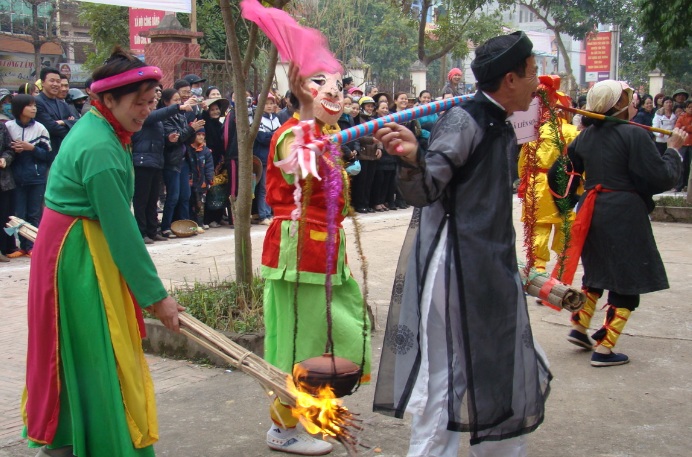
BAT TRANG CERAMIC VILLAGE FESTIVAL
The ceramic village of Bat Trang is located on the left bank of the Red River about ten kilometers from downtown Hanoi. Its subtle ceramic products are known both inside and outside the country. Every year, the village of Bat Trang organizes a festival from the 14th to the 16th day of the 2nd lunar month. This festival is for the purpose of honoring the tradition of Bat Trang village and reminding the children of the root. In addition to traditional rites, it is also an opportunity to introduce ceramic products to tourists. So, if you participate, you can admire the ceramic products made by the skilled hands of artisans
MASTER PAGODA FESTIVAL (Chùa Thầy))
Every year, the Thay Pagoda Festival takes place on the 7th day of the 3rd lunar month. This is an opportunity to memorize the contributions of monk Tu Dao Hanh, founder of Vietnamese water puppets. In this festival, we organize a procession of the tablet, the cult to Buddha, the representation of puppets on the water. For some tourists, it is not only a pilgrimage but also an opportunity to contemplate the beauty of a cultural heritage, where traces of personalities, senior monks of several periods are still engraved.

